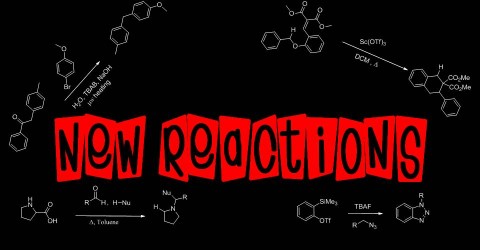
Woolven, H.; González-Rodríguez, C.; Marco, I.; Thompson, A.L.; Willis, M.C. Org. Lett. ASAP August 25, 2011
I’m alive! And I finally have power back. However most of Connecticut still is without power thanks to our lovely encounter with Irene. My girlfriend and I actually ended up going to back to my house in NY and rode out the hurricane there. Was it scary? Not at all, it was more of an annoyance with intermittent power. However, for those who were traveling, Irene really took a toll. NY airports were completely closed as were many other major ones. Professor Tilley, who gave an excellent talk at the ACS conference today, managed to fly out to Denver with minimal delays. He presented some of the stuff we’ve been working on as part of our collaboration. Speaking of collaborations, our paper with Dr. Fenteany’s group should be submitted shortly after some delay. I’ll be sure to keep you updated on that as well. As for my own projects, I continue to wrap up the project that was assigned to our undergrads. We had to expand it a bit but I feel like this is going to be an amazing paper. I’ve already been writing it up and, next to my work as an undergrad, it’s been the most enjoyable piece of work I’ve had to write. Moreover, the project itself has allowed me to do all sorts of reactions that I never done before and for someone who loves doing reactions like I do it’s like Christmas. I did my first Sonogashira coupling and it was a great success! I did a few more lithium-halogen exchanges, as well as some silyl protections. Each day I feel more and more like a hardcore organic chemist! I even submitted two of my best procedures to ChemSpider and I’ll be submitting more over the next couple of days. I’ll be sure to put up links to them.
Now that Irene is gone (finally), what better way to celebrate having power back than with a little chemistry? This week’s article comes again from Org. Lett. and really caught my attention due to the name. I love when new reagents are developed (mostly because it is a rare occurrence). This one looks to be very promising. In some ways it reminds me of another useful reagent, Selectfluor®. Selectfluor® is an excellent source of electrophilic fluorine and can be used in a variety of reactions, such as α-fluorination of carbonyl compounds. DABSO, on the other hand, promises to be a source of “SO2” without having to use it in a gaseous state. In fact, SO2 is very toxic and a pain to work with. Unfortunately, the synthesis of many sulfur-based compounds relies on SO2 gas as a sulfur source. For example, the synthesis of many sulfones and sulfinates hinge on SO2. Moreover, SO2 gas is useful for a number of reactions including cheletropic additions and the synthesis of aromatic sulfonyl chlorides. So having a less toxic and easy to work with source of SO2 would be quite attractive
When SO2 is reacted with an amine a charge-transfer complex is formed. Now what is that you may ask? According to Wiki, these complexes occur when “a fraction of electronic charge is transferred between two molecular entities. The resulting electrostatic attraction provides a stabilizing force for the molecular complex.” They usually occur more in inorganic chemistry hence why I’m not all too familiar with it. With this knowledge in mind, the authors therefore decided to react DABCO with SO2 gas to see if a stable complex resulted. And it in fact did. It is air-stable and can be stored on the bench-top indefinitely. But can it serve as a SO2 surrogate?
Apparently the Willis group had already published on DABSO. In the presence of a palladium catalyst and hydrazine compounds, they were able to effect aminosulfonylation by using DABSO as a SO2 source. This was an unprecedented transformation and gave excellent yields starting from simple aryl iodides. However, after this article they wanted to test the limits of DABSO’s abilities. The authors decided to investigate whether DABSO could be used in more traditional SO2 reactions. The first reaction they attempted was based off some work done by the Barrett group. Barrett was able to take aryl Grignard reagents and hit them with SO2 gas. He followed that up with treatment with sulfuryl chloride and a secondary to give sulfonamides in excellent yields. Willis and his group followed up on that by replacing SO2 with DABSO and report that it served as a comparable source of SO2 as the gas itself. In fact they even went beyond the scope that Barrett originally investigated by adding primary amines and alkyl Grignards to the mix.
Next Willis examined another interesting reaction involving SO2. Rudkevich and his group reported that treatment of anilines with I2 in acetonitrile at 0 oC in the presence of pyridine and SO2 gas yielded symmetrical diarylsulfamides. However roughly 100 equivalents of SO2 was needed to obtain acceptable yields. Capitalizing on this, Willis and his group were able to use only 2 stiochiometric equivalents of DABSO to obtain similar results under identical conditions.
Lastly, to show the breadth of the scope of DABSO, Willis investigated whether it could be used in a cheletropic additionreaction. Interestingly, heating in a sealed tube with just DABSO and a diene afforded the sulfolene product in excellent yield. I think Willis definitely proved his case that DABSO is a perfect SO2 sources whose application has yet to fully be explored. However, its certainly looking like this will be a reagent for any chemist looking to engage in sulfur work. Hats off to Willis and his group for an excellent paper! That’s all for now, Ckellz…signing off…










